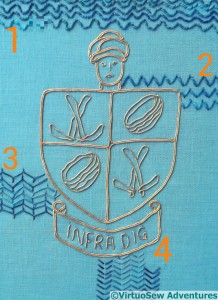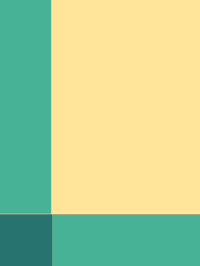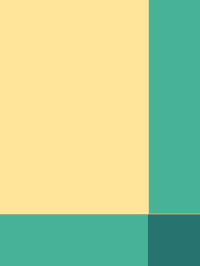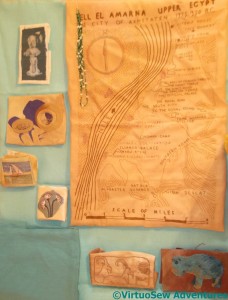The Plan for the Dreams of Amarna
I had several very useful comments after my last post, but they all (understandably!) failed to take into account my overall plan for this project.
So, a quick re-cap, for the benefit of everyone who hasn’t (unlike me) been thinking about the Dreams of Amarna for the last twenty years. I first wrote about this in March 2010, but I first started thinking of an embroidery project inspired by the book “Nefertiti Lived Here” a good fifteen years before that!
I thought about various ideas for the Amarna embroidery for a good five or ten years, on and off, but then it finally came together in about 2008 during conversations with my cousin. In fact I started this blog partly in order to give myself a push, and to make sure that I kept at it.
My idea at the moment is for two large panels, which will be colour-blocked as mirror images of one another using sandy colours (for the desert) and turquoise (for the faience used so often in ancient Egypt).
The sandy panels are about 35 centimetres by 50 centimetres, and getting the right proportions for the turquoise will be very important.
These panels will be overlaid with a gauze layer, screen printed with the heads of Akhenaten and Neferetiti. I have already done some experiments with screen printing on gauze, and I know that not only will it be rather tricky to find the right gauze, but working out how to hang it is going to be a real challenge. The gauze overlay means that colours that are subdued may not show strongly enough – in fact some of my early pieces for the project may end up being mounted as standalone pieces, for that very reason.
This post, from earlier this year, gives you a very rough idea of how the layout may look.
The Antelope Frieze and the Felucca may both turn out to be too inspidly coloured to show through.





It’s going to be fabulous when it’s finished.
You can mount items on top of silk gauze like appliquéd slips. That may not fit your vision, but it would work.
Thanks for writing this overview – I needed it. I came in part way through this project and missed a lot of the backstory. The veils will be a challenge, I can see that. I’m thinking that you could hinge your gauze panels to swing out sideways like a pair of doors on a cabinet, to allow the viewer to see the interior pieces close-up if they like. That way, anything that is a little hard to make out through the veils acts as a ‘teaser’ to open the doors and take a closer look, and the veil can bee a tiny bit less transparent without any risk of hiding things for good. And the idea of a cabinet seems to fit with the revealing the buried treasures in Tel Amarna.
Thanks for the explanation. What an undertaking!!! I so admire your ‘gumption’ and skills. I hadn’t thought about (or realized) the gauze when I made an earlier comment — this makes it much clearer. Congratulations on the completed goldwork.
I don’t feel so bad now about how long some of my projects have been on the go!!
It is good to know that I am not alone in having a long gestation period for some of my projects.
definitely a labour of love Rachel, you are investing so much into this.
Rachel, although I do not understand much about it, your blog is inspiring. You’re brilliant in all aspects of stitches.
Ah, well I not only understood all of the above but I have seen some of the worked pieces in the flesh as it were. So I am very familiar with the importance of and yet problems associated with the gauze overlay! I do like Sue’s suggestion though.
It’s been far too long since I came and had a proper look at your work but in some ways, to have a load of posts to go at has been really interesting, particularly with the evolution of your Amarna panel. It’s a delight of little objet d’art, rather like uncovering those amazing artefacts on a dig.